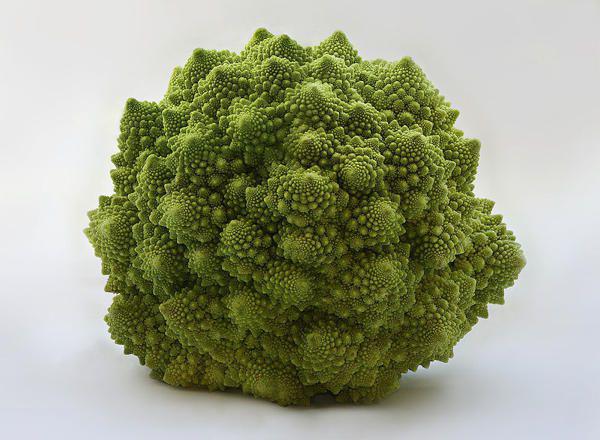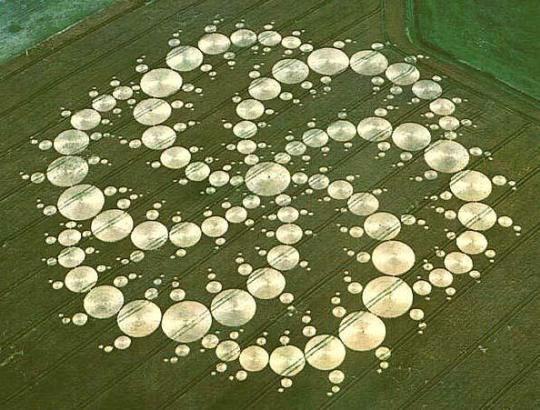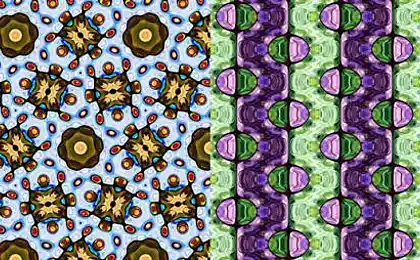1214
Symmetry in nature
For centuries, the symmetry remains a subject that fascinated philosophers, astronomers, mathematicians, artists, architects and physicists. The ancient Greeks were completely obsessed by it - and even today we are usually faced with a symmetry in everything from planning the location of our furniture to cutting hair.

Broccoli romanesco
Perhaps seeing broccoli romanesco in a store, you're thinking that this is one more sample of genetically modified food. But in fact, this is another example of fractal symmetry of nature. Each inflorescence of broccoli has a pattern of logarithmic spiral. Romanesco broccoli is similar in appearance and taste and consistency - cauliflower. It is rich in carotenoids and vitamins C and K, which makes it not only beautiful, but also healthy food.

Honeycomb
For thousands of years, people have wondered ideal hexagonal honeycomb and wondered how bees can instinctively create a form that people can reproduce only by means of a ruler and compass. How and why the bees have a passionate desire to create hexagons? Mathematicians believe that this is the ideal form, which allows them to store the maximum possible amount of honey, using the minimum amount of wax. In any case, it's all a product of nature, and it is pretty darn impressive.

Sunflowers
Sunflowers can boast of radial symmetry and interesting type of symmetry, known as the Fibonacci sequence. The Fibonacci sequence: 1, 2, 3, 5, 8, 13, 21, 24, 55, 89, 144, etc. (each number is the sum of the two previous numbers). If we do not hurry up and counted the number of seeds in a sunflower, we would find that the number of spirals growing on the principles of the Fibonacci sequence. In nature, there are a lot of plants (including broccoli romanesco), petals, seeds and leaves that meet this sequence, so it is difficult to find a clover with four leaves.
But why sunflowers and other plants comply with the rules of mathematics? Like the hexagons in the hive, all this - the question of efficiency.

Nautilus
In addition to plants, some animals, such as Nautilus, meet the Fibonacci sequence. Nautilus shell twists in the "Fibonacci spiral." Shell tries to maintain the same proportional shape, allowing it to maintain it throughout life (as opposed to people who are changing the proportions of lifetime). Not all have the Nautilus shell, lined up on the rules of the Fibonacci, but they all meet the logarithmic spiral.
Before you pozaviduete shellfish mathematician, remember that they do not do it on purpose, just a form of the most rational for them.

Pets
Most animals have bilateral symmetry, meaning that they can be divided into two identical halves. Even people who have bilateral symmetry, and some scientists believe that the symmetry of the human being is the most important factor that influences our perception of beauty. In other words, if you have a one-sided person, it is hoped that this is compensated by other good qualities.
Some reach full symmetry in an effort to attract a partner, such as Peacock. Darwin was positively annoyed by this bird, and wrote in a letter that "the type of feathers in a peacock's tail, whenever I look at it, makes me sick!" Darwin, the tail seemed cumbersome and do not have an evolutionary sense, since it did not meet his theory of "survival of the fittest." He was furious until he came up with the theory of sexual selection, which states that animals develop certain functions in order to increase their chances of mating. Why peacocks have different tools to attract partner.

Web
There are about 5,000 types of spiders, and they create an almost perfect circular blade with radial supporting threads almost equidistant and spiral cloth to catch prey. Scientists are not sure why spiders are so fond of geometry, as tests have shown that the round belt does not lure the food is better than the web of irregular shape. Scientists suggest that the radial symmetry distributes the force of impact when the victim gets on the network, resulting in less disruption.

Crop Circles
Give a couple of cheaters board mowers and saving the darkness, and you will see that people also create a symmetrical shape. Due to the fact that the crop circles are complex design and incredible symmetry, even after the creators of the community to recognize and demonstrate their skills, many people still believe that it did space aliens.
As the complexity of community has become increasingly clear their artificial origin. It is illogical to assume that aliens will make your posts more difficult when we are not able to decipher even the first of them.
No matter how they get there, the crop circles nice treat, mainly because their geometry is impressive.

Snowflakes
Even such tiny education, like snowflakes, are governed by the laws of symmetry, as the majority has a hexagonal symmetry of snowflakes. This occurs in part due to how water molecules line up when solidify (crystallize). The water molecules become solid state, forming a weak hydrogen bonds, they are aligned in an orderly arrangement that balances the forces of attraction and repulsion, forming a hexagonal shape of snowflakes. However, each snowflake is symmetrical, but no snowflake is not like another. This is because falling from the sky, each snowflake is experiencing the unique atmospheric conditions that make its crystals arranged in a certain way.

Milky Way Galaxy
As we have seen, the symmetry and mathematical models exist almost everywhere, but is limited by the laws of nature of our planet? Obviously not. Recently opened a new section on the edge of the Milky Way galaxy, and astronomers believe that the galaxy is almost a perfect mirror image of himself.

The symmetry of the Sun-Moon
Considering that the Sun has a diameter of 1, 4 million. Km, and the Moon - 3474 km, it seems almost impossible that the Moon can block sunlight and provides us with about five solar eclipses every two years. How does it work? Coincidentally, along with the fact that the width of the Sun is about 400 times larger than the Moon, the Sun and 400 times farther away. Symmetry provides that the Sun and the Moon obtained the same size as seen from Earth, so the Moon can cover the sun. Of course, the distance from Earth to the sun can increase, so sometimes we see and annular partial eclipse. But every one to two years, takes precise alignment, and we witness a spectacular event known as a total solar eclipse. Astronomers do not know how common such a symmetry among the other planets, but they think it's pretty rare. Nevertheless, we should not assume that we are special, because it all a matter of chance. For example, every year the moon moves away about 4 cm from the ground, which means that billions of years ago, every solar eclipse would be total eclipse. If things keep going like this, the total eclipse, in the end, disappear, and it will be accompanied by the disappearance of the annular eclipse. It turns out that we were just in the right place at the right time to see this phenomenon.

Source: bigpicture.ru

Broccoli romanesco
Perhaps seeing broccoli romanesco in a store, you're thinking that this is one more sample of genetically modified food. But in fact, this is another example of fractal symmetry of nature. Each inflorescence of broccoli has a pattern of logarithmic spiral. Romanesco broccoli is similar in appearance and taste and consistency - cauliflower. It is rich in carotenoids and vitamins C and K, which makes it not only beautiful, but also healthy food.

Honeycomb
For thousands of years, people have wondered ideal hexagonal honeycomb and wondered how bees can instinctively create a form that people can reproduce only by means of a ruler and compass. How and why the bees have a passionate desire to create hexagons? Mathematicians believe that this is the ideal form, which allows them to store the maximum possible amount of honey, using the minimum amount of wax. In any case, it's all a product of nature, and it is pretty darn impressive.

Sunflowers
Sunflowers can boast of radial symmetry and interesting type of symmetry, known as the Fibonacci sequence. The Fibonacci sequence: 1, 2, 3, 5, 8, 13, 21, 24, 55, 89, 144, etc. (each number is the sum of the two previous numbers). If we do not hurry up and counted the number of seeds in a sunflower, we would find that the number of spirals growing on the principles of the Fibonacci sequence. In nature, there are a lot of plants (including broccoli romanesco), petals, seeds and leaves that meet this sequence, so it is difficult to find a clover with four leaves.
But why sunflowers and other plants comply with the rules of mathematics? Like the hexagons in the hive, all this - the question of efficiency.

Nautilus
In addition to plants, some animals, such as Nautilus, meet the Fibonacci sequence. Nautilus shell twists in the "Fibonacci spiral." Shell tries to maintain the same proportional shape, allowing it to maintain it throughout life (as opposed to people who are changing the proportions of lifetime). Not all have the Nautilus shell, lined up on the rules of the Fibonacci, but they all meet the logarithmic spiral.
Before you pozaviduete shellfish mathematician, remember that they do not do it on purpose, just a form of the most rational for them.

Pets
Most animals have bilateral symmetry, meaning that they can be divided into two identical halves. Even people who have bilateral symmetry, and some scientists believe that the symmetry of the human being is the most important factor that influences our perception of beauty. In other words, if you have a one-sided person, it is hoped that this is compensated by other good qualities.
Some reach full symmetry in an effort to attract a partner, such as Peacock. Darwin was positively annoyed by this bird, and wrote in a letter that "the type of feathers in a peacock's tail, whenever I look at it, makes me sick!" Darwin, the tail seemed cumbersome and do not have an evolutionary sense, since it did not meet his theory of "survival of the fittest." He was furious until he came up with the theory of sexual selection, which states that animals develop certain functions in order to increase their chances of mating. Why peacocks have different tools to attract partner.

Web
There are about 5,000 types of spiders, and they create an almost perfect circular blade with radial supporting threads almost equidistant and spiral cloth to catch prey. Scientists are not sure why spiders are so fond of geometry, as tests have shown that the round belt does not lure the food is better than the web of irregular shape. Scientists suggest that the radial symmetry distributes the force of impact when the victim gets on the network, resulting in less disruption.

Crop Circles
Give a couple of cheaters board mowers and saving the darkness, and you will see that people also create a symmetrical shape. Due to the fact that the crop circles are complex design and incredible symmetry, even after the creators of the community to recognize and demonstrate their skills, many people still believe that it did space aliens.
As the complexity of community has become increasingly clear their artificial origin. It is illogical to assume that aliens will make your posts more difficult when we are not able to decipher even the first of them.
No matter how they get there, the crop circles nice treat, mainly because their geometry is impressive.

Snowflakes
Even such tiny education, like snowflakes, are governed by the laws of symmetry, as the majority has a hexagonal symmetry of snowflakes. This occurs in part due to how water molecules line up when solidify (crystallize). The water molecules become solid state, forming a weak hydrogen bonds, they are aligned in an orderly arrangement that balances the forces of attraction and repulsion, forming a hexagonal shape of snowflakes. However, each snowflake is symmetrical, but no snowflake is not like another. This is because falling from the sky, each snowflake is experiencing the unique atmospheric conditions that make its crystals arranged in a certain way.

Milky Way Galaxy
As we have seen, the symmetry and mathematical models exist almost everywhere, but is limited by the laws of nature of our planet? Obviously not. Recently opened a new section on the edge of the Milky Way galaxy, and astronomers believe that the galaxy is almost a perfect mirror image of himself.

The symmetry of the Sun-Moon
Considering that the Sun has a diameter of 1, 4 million. Km, and the Moon - 3474 km, it seems almost impossible that the Moon can block sunlight and provides us with about five solar eclipses every two years. How does it work? Coincidentally, along with the fact that the width of the Sun is about 400 times larger than the Moon, the Sun and 400 times farther away. Symmetry provides that the Sun and the Moon obtained the same size as seen from Earth, so the Moon can cover the sun. Of course, the distance from Earth to the sun can increase, so sometimes we see and annular partial eclipse. But every one to two years, takes precise alignment, and we witness a spectacular event known as a total solar eclipse. Astronomers do not know how common such a symmetry among the other planets, but they think it's pretty rare. Nevertheless, we should not assume that we are special, because it all a matter of chance. For example, every year the moon moves away about 4 cm from the ground, which means that billions of years ago, every solar eclipse would be total eclipse. If things keep going like this, the total eclipse, in the end, disappear, and it will be accompanied by the disappearance of the annular eclipse. It turns out that we were just in the right place at the right time to see this phenomenon.

Source: bigpicture.ru























